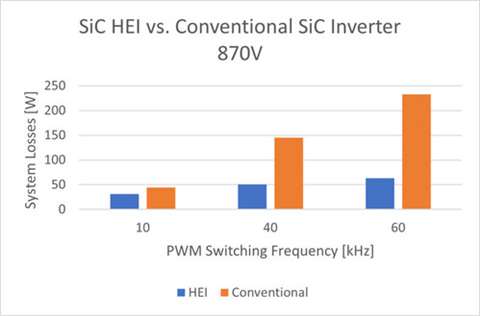Hillcrest reveals testing results for SiC HEI invertor
26 November 2021
 Hillcrest achieves technical proof of concept for high efficiency inverter
Hillcrest achieves technical proof of concept for high efficiency inverter
Hillcrest Energy Technologies, a Canadian company specialising in development of hardware for electric powertrains, has reported achieving further proof of concept for its silicon carbide high-efficiency (SiC HEI) invertor.
The data is said to confirm the ability to eliminate switching losses and increase switching frequencies without increasing temperature.
The company’s SiC HEI is a 10 kW/800 volt inverter based on silicon carbide semi-conductors. 800 volts was selected as the level to match designs now being adopted for most recent EV powertrain configurations.
The resulting temperature increase from using the SiC HEI converter is ‘significantly lower’ than current invertor technologies. This could result in significant design and performance improvements for future electric vehicle powertrains.
The SiC HEI invertor is stated as having the ability to significantly increase power density, while also reducing cost, size and weight.
Ari Berger, Hillcrest CTO, said: “We are thrilled to share the results we’ve achieved thus far with the SiC HEI and continue to work with our development partners at Systematec to further improve and optimize with a specific focus not just on eliminating switching losses, but further reducing total system losses in our SiC HEI inverter.”
A benchmark test compared the performance of the SiC HEI PoC to a conventional SiC inverter. The parameters for these tests ranged from 470 to 870 volts, with frequencies from 10 kHz to 60 kHz at each voltage level. In each case, the SiC HEI PoC successfully demonstrated its ability to eliminate switching losses and increase switching frequencies without increasing the SiC temperatures under continuous operation.
The SiC HEI PoC dramatically reduces total system losses as switching frequencies increase (10 kHz up to 60 kHz) when compared to a conventional SiC inverter. As the efficiencies achieved by the HEI continue to approach theoretical limits, very accurate measurements were required to precisely quantify HEI efficiency performance.
STAY CONNECTED




Receive the information you need when you need it through our world-leading magazines, newsletters and daily briefings.
POWER SOURCING GUIDE
The trusted reference and buyer’s guide for 83 years
The original “desktop search engine,” guiding nearly 10,000 users in more than 90 countries it is the primary reference for specifications and details on all the components that go into engine systems.
Visit Now
CONNECT WITH THE TEAM










